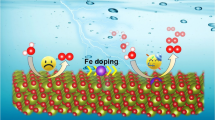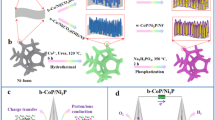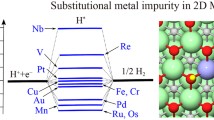Abstract
The basal planes of transition metal dichalcogenides are basically inert for catalysis due to the absence of adsorption and activation sites, which substantially limit their catalytic application. Herein, a facile strategy to activate the basal plane of WS2 for hydrogen evolution reaction (HER) catalysis by phosphorous-induced electron density modulation is demonstrated. The optimized P doped WS2 (P-WS2) nanowires arrays deliver a low overpotential of 88 mV at 10 mA·cm−2 with a Tafel slope of 62 mV·dec−1 for HER, which is substantially better than the pristine counterpart. X-ray photoelectron spectroscopy confirms the surface electron densities of WS2 have been availably manipulated by P doping. Moreover, density functional theory (DFT) studies further prove P doping can redistribute the density of states (DOS) around EF, which endow the inert basal plane of P-WS2 with edge-like catalytic activity toward hydrogen evolution catalysis. Our work offers a facile and effective approach to modulate the catalytic surface of WS2 toward highly efficient HER catalysis.

Similar content being viewed by others
References
Stamenkovic, V. R.; Strmcnik, D.; Lopes, P. P.; Markovic, N. M. Energy and fuels from electrochemical interfaces. Nat. Mater.2017, 16, 57–69.
Wüstenhagen, R.; Bilharz, M. Green energy market development in Germany: Effective public policy and emerging customer demand. Energy Policy2006, 34, 1681–1696.
Gao, M. R.; Chan, M. K. Y.; Sun, Y. G. Edge-terminated molybdenum disulfide with a 9.4-Å interlayer spacing for electrochemical hydrogen production. Nat. Commun.2015, 6, 7493.
Zhou, X. W.; Gan, Y. L.; Du, J. J.; Tian, D. N.; Zhang, R. H.; Yang, C. Y.; Dai, Z. X. A review of hollow Pt-based nanocatalysts applied in proton exchange membrane fuel cells. J. Power Sources2013, 232, 310–322.
Tran, P. D.; Nguyen, M.; Pramana, S. S.; Bhattacharjee, A.; Chiam, S. Y.; Fize, J.; Field, M. J.; Artero, V.; Wong, L. H.; Loo, J. et al. Copper molybdenum sulfide: A new efficient electrocatalyst for hydrogen production from water. Energy Environ. Sci.2012, 5, 8912–8916.
Jiang, P.; Liu, Q.; Liang, Y. H.; Tian, J. Q.; Asiri, A. M.; Sun, X. P. A cost-effective 3D hydrogen evolution cathode with high catalytic activity: FeP nanowire array as the active phase. Angew. Chem.2014, 126, 13069–13073.
Peng, S. J.; Li, L. L.; Han, X. P.; Sun, W. P.; Srinivasan, M.; Mhaisalkar, S. G.; Cheng, F. Y.; Yan, Q. Y.; Chen, J.; Ramakrishna, S. Cobalt sulfide nanosheet/graphene/carbon nanotube nanocomposites as flexible electrodes for hydrogen evolution. Angew. Chem., Int. Ed.2014, 53, 12594–12599.
Wang, Q. H.; Kalantar-Zadeh, K.; Kis, A.; Coleman, J. N.; Strano, M. S. Electronics and optoelectronics of two-dimensional transition metal dichalcogenides. Nat. Nanotechnol.2012, 7, 699–712.
Zhang, K.; Zhao, Y.; Zhang, S.; Yu, H. L.; Chen, Y. J.; Gao, P.; Zhu, C. L. MoS2 nanosheet/Mo2C-embedded N-doped carbon nanotubes: Synthesis and electrocatalytic hydrogen evolution performance. J. Mater. Chem. A2014, 2, 18715–18719.
Zhang, K.; Zhao, Y.; Fu, D. Y.; Chen, Y. J. Molybdenum carbide nanocrystal embedded N-doped carbon nanotubes as electrocatalysts for hydrogen generation. J. Mater. Chem. A2015, 3, 5783–5788.
Yu, H. L.; Yu, X. B.; Chen, Y. J.; Zhang, S.; Gao, P.; Li, C. Y. A strategy to synergistically increase the number of active edge sites and the conductivity of MoS2 nanosheets for hydrogen evolution. Nanoscale2015, 7, 8731–8738.
Zang, Y. P.; Niu, S. W.; Wu, Y. S.; Zheng, X. S.; Cai, J. Y.; Ye, J.; Xie, Y. F.; Liu, Y.; Zhou, J. B.; Zhu, J. F. et al. Tuning orbital orientation endows molybdenum disulfide with exceptional alkaline hydrogen evolution capability. Nat. Commun.2019, 10, 1217.
Xie, H. P.; Lan, C.; Chen, B.; Wang, F. H.; Liu, T. Noble-metal-free catalyst with enhanced hydrogen evolution reaction activity based on granulated Co-doped Ni-Mo phosphide nanorod arrays. Nano Res.2020, 13, 3321–3329.
Niu, S. W.; Cai, J. Y.; Wang, G. M. Two-dimensional MoS2 for hydrogen evolution reaction catalysis: The electronic structure regulation. Nano Res.2021, 14, 1985–2002.
Zhu, J. H.; Chen, Z.; Jia, L.; Lu, Y. Q.; Wei, X. R.; Wang, X. N.; Wu, W. D.; Han, N.; Li, Y. G.; Wu, Z. X. Solvent-free nanocasting toward universal synthesis of ordered mesoporous transition metal sulfide@N-doped carbon composites for electrochemical applications. Nano Res.2019, 12, 2250–2258.
Chen, M. H.; Liu, J. L.; Zhou, W. J.; Lin, J. Y.; Shen, Z. X. Nitrogen-doped graphene-supported transition-metals carbide electrocatalysts for oxygen reduction reaction. Sci. Rep.2015, 5, 10389.
Chen, M. H.; Qi, M. L.; Yin, J. H.; Chen, Q. G. Embedding sulfur into N-doped carbon nanospheres as enhanced cathode for highperformance lithium-sulfur batteries. Mater. Res. Bull.2017, 96, 335–339.
Li, Y.; Chen, M. H.; Liu, B.; Zhang, Y.; Liang, X. Q.; Xia, X. H. Heteroatom doping: An effective way to boost sodium ion storage. Adv. Energy Mater.2020, 10, 2000927.
Wu, Y. S.; Liu, X. J.; Han, D. D.; Song, X. Y.; Shi, L.; Song, Y.; Niu, S. W.; Xie, Y. F.; Cai, J. Y.; Wu, S. Y. et al. Electron density modulation of NiCo2S4 nanowires by nitrogen incorporation for highly efficient hydrogen evolution catalysis. Nat. Commun.2018, 9, 1425.
Wang, S. Q.; Xia, L.; Yu, L.; Zhang, L.; Wang, H. H.; Lou, X. W. Free-standing nitrogen-doped carbon nanofiber films: Integrated electrodes for sodium-ion batteries with ultralong cycle life and superior rate capability. Adv. Energy Mater.2016, 6, 1502217.
Shi, Z. P.; Nie, K. Q.; Shao, Z. J.; Gao, B. X.; Lin, H. L.; Zhang, H. B.; Liu, B. L.; Wang, Y. X.; Zhang, Y. H.; Sun, X. H. et al. Phosphorus-Mo2C@ carbon nanowires toward efficient electrochemical hydrogen evolution: Composition, structural and electronic regulation. Energy Environ. Sci.2017, 10, 1262–1271.
Kibsgaard, J.; Jaramillo, T. F. Molybdenum phosphosulfide: An active, acid-stable, earth-abundant catalyst for the hydrogen evolution reaction. Angew. Chem., Int. Ed.2014, 53, 14433–14437.
Zhang, X.; Liang, Y. Y. Nickel hydr(oxy)oxide nanoparticles on metallic MoS2 nanosheets: A synergistic electrocatalyst for hydrogen evolution reaction. Adv. Sci.2018, 5, 1700644.
Wang, H. Q.; Zhang, W. J.; Zhang, X. W.; Hu, S. X.; Zhang, Z. C.; Zhou, W. J.; Liu, H. Multi-interface collaboration of graphene cross-linked NiS-NiS2-Ni3S4 polymorph foam towards robust hydrogen evolution in alkaline electrolyte. Nano Res., in press, https://doi.org/10.1007/s12274-021-3445-5.
Kang, X.; Liu, J. C.; Tian, C. G.; Wang, D. X.; Li, Y. R.; Zhang, H. Y.; Cheng, X. S.; Wu, A. P.; Fu, H. G. Surface curvature-confined strategy to ultrasmall nickel-molybdenum sulfide nanoflakes for highly efficient deep hydrodesulfurization. Nano Res.2020, 13, 882–890.
Wang, F.; Li, Y.; Xia, X. H.; Cai, W.; Chen, Q. G.; Chen, M. H. Metal-CO2 electrochemistry: From CO2 recycling to energy storage. Adv. Energy Mater.2021, 11, 2100667.
Li, P. H.; Yang, Y.; Gong, S.; Lv, F.; Wang, W.; Li, Y. J.; Luo, M. C.; Xing, Y.; Wang, Q.; Guo, S. J. Co-doped 1T-MoS2 nanosheets embedded in N, S-doped carbon nanobowls for high-rate and ultrastable sodium-ion batteries. Nano Res.2019, 12, 2218–2223.
Lu, C. H.; Hon, M. H.; Kuan, C. Y.; Leu, I. C. Preparation of WO3 nanorods by a hydrothermal method for electrochromic device. J. Appl. Phys.2014, 53, 06JG08.
Bai, S. L.; Zhang, K. W.; Luo, R. X.; Li, D. Q.; Chen, A. F.; Liu, C. C. Low-temperature hydrothermal synthesis of WO3 nanorods and their sensing properties for NO2. J. Mater. Chem.2012, 22, 12643–12650.
Han, D. D.; Liu, X. J.; Cai, J. Y.; Xie, Y. F.; Niu, S. W.; Wu, Y. S.; Zang, Y. P; Fang, Y. Y.; Zhao, F. Q.; Qu, W. G. et al. Superior surface electron energy level endows WP2 nanowire arrays with N2 fixation functions. J. Energy Chem.2021, 59, 55–62.
Wang, X. D.; Xu, Y. F.; Rao, H. S.; Xu, W. J.; Chen, H. Y.; Zhang, W. X.; Kuang, D. B.; Su, C. Y. Novel porous molybdenum tungsten phosphide hybrid nanosheets on carbon cloth for efficient hydrogen evolution. Energy Environ. Sci.2016, 9, 1468–1475.
Zhang, X.; Zhou, F.; Pan, W. Y.; Liang, Y. Y.; Wang, R. H. General construction of molybdenum-based nanowire arrays for pH-universal hydrogen evolution electrocatalysis. Adv. Funct. Mater.2018, 28, 1804600.
Ouyang, C. B.; Wang, X.; Wang, S. Y. Phosphorus-doped CoS2 nanosheet arrays as ultra-efficient electrocatalysts for the hydrogen evolution reaction. Chem. Commun.2015, 51, 14160–14163.
Wang, Z. Q.; Liu, P.; Ito, Y.; Ning, S. C.; Tan, Y. W.; Fujita, T.; Hirata, A.; Chen, M. W. Chemical vapor deposition of monolayer Mo1−xWxS2 crystals with tunable band gaps. Sci. Rep.2016, 6, 21536.
Li, Y. H.; Liu, P. F.; Pan, L. F.; Wang, H. F.; Yang, Z. Z.; Zheng, L. R.; Hu, P.; Zhao, H. J.; Gu, L.; Yang, H. G. Local atomic structure modulations activate metal oxide as electrocatalyst for hydrogen evolution in acidic water. Nat. Commun.2015, 6, 8064.
Shifa, T. A.; Wang, F. M.; Liu, K. L.; Cheng, Z. Z.; Xu, K.; Wang, Z. X.; Zhan, X. Y.; Jiang, C.; He, J. Efficient catalysis of hydrogen evolution reaction from WS2(1−x)P2x nanoribbons. Small2017, 13, 1603706.
McEnaney, J. M.; Crompton, J. C.; Callejas, J. F.; Popczun, E. J.; Read, C. G.; Lewis, N. S.; Schaak, R. E. Electrocatalytic hydrogen evolution using amorphous tungsten phosphide nanoparticles. Chem. Commun.2014, 50, 11026–11028.
Han, N.; Yang, K. R.; Lu, Z. Y.; Li, Y. J.; Xu, W. W.; Gao, T. F.; Cai, Z.; Zhang, Y.; Batista, V. S.; Liu, W. et al. Nitrogen-doped tungsten carbide nanoarray as an efficient bifunctional electrocatalyst for water splitting in acid. Nat. Commun.2018, 9, 924.
Wang, Y. Q.; Xie, Y.; Zhao, L.; Sui, X. L.; Gu, D. M.; Wang, Z. B. Hierarchical heterostructured Mo2C/Mo3Co3C bouquet-like nanowire arrays: An efficient electrocatalyst for hydrogen evolution reaction. ACS Sustainable Chem. Eng.2019, 7, 7294–7303.
Zhang, Y. Q.; Ouyang, B.; Xu, J.; Chen, S.; Rawat, R. S.; Fan, H. J. 3D porous hierarchical nickel-molybdenum nitrides synthesized by RF plasma as highly active and stable hydrogen-evolution-reaction electrocatalysts. Adv. Energy Mater.2016, 6, 1600221.
Zhang, Y. Q.; Xia, X. H.; Cao, X.; Zhang, B. W.; Tiep, N. H.; He, H. Y.; Chen, S.; Huang, Y. Z.; Fan, H. J. Ultrafine metal nanoparticles/N-doped porous carbon hybrids coated on carbon fibers as flexible and binder-free water splitting catalysts. Adv. Energy Mater.2017, 7, 1700220.
Blöchl, P. E. Projector augmented-wave method. Phys. Rev. B1994, 50, 17953.
Deng, S. J.; Zhong, Y.; Zeng, Y. X.; Wang, Y. D.; Yao, Z. J.; Yang, F.; Lin, S. W.; Wang, X. L.; Lu, X. H.; Xia, X. H. et al. Directional construction of vertical nitrogen-doped 1T-2H MoSe2/graphene shell/core nanoflake arrays for efficient hydrogen evolution reaction. Adv. Mater.2017, 29, 1700748.
Niu, S. W.; Fang, Y. Y.; Zhou, J. B.; Cai, J. Y.; Zang, Y. P.; Wu, Y. S.; Ye, J.; Xie, Y. F.; Liu, Y.; Zheng, X. S. et al. Manipulating the water dissociation kinetics of Ni3N nanosheets via in situ interfacial engineering. J. Mater. Chem. A2019, 7, 10924–10929.
Ren, H. J.; Pan, Y.; Sorrell, C. C.; Du, H. W. Assessment of electrocatalytic activity through the lens of three surface area normalization techniques. J. Mater. Chem. A2020, 8, 3154–3159.
Feng, Y. Q.; Wang, X.; Dong, P. P.; Li, J.; Feng, L.; Huang, J. F.; Cao, L. Y.; Feng, L. L.; Kajiyoshi, K.; Wang, C. R. Boosting the activity of Prussian-blue analogue as efficient electrocatalyst for water and urea oxidation. Sci. Rep.2019, 9, 15965.
Liang, X. Q.; Chen, M. H.; Zhu, H. K.; Zhu, H.; Cui, X. H.; Yan, J. X.; Chen, Q. G.; Xia, X. H.; Liu, Q. Unveiling the solid-solution charge storage mechanism in 1T vanadium disulfide nanoarray cathodes. J. Mater. Chem. A2020, 8, 9068–9076.
Chen, M. H.; Fan, H.; Zhang, Y.; Liang, X. Q.; Chen, Q. G.; Xia, X. H. Coupling PEDOT on mesoporous vanadium nitride arrays for advanced flexible all-solid-state supercapacitors. Small2020, 16, 2003434.
Sokolikova, M. S.; Sherrell, P. C.; Palczynski, P.; Bemmer, V. L.; Mattevi, C. Direct solution-phase synthesis of 1T’ WSe2 nanosheets. Nat. Commun.2019, 10, 712.
Zhang, Y. Q.; Ouyang, B.; Xu, K.; Xia, X. H.; Zhang, Z.; Rawat, R. S.; Fan, H. J. Prereduction of metal oxides via carbon plasma treatment for efficient and stable electrocatalytic hydrogen evolution. Small2018, 14, 1800340.
Deng, J.; Li, H. B.; Xiao, J. P.; Tu, Y. C.; Deng, D. H.; Yang, H. X.; Tian, H. F.; Li, J. Q.; Ren, P. J.; Bao, X. H. Triggering the electrocatalytic hydrogen evolution activity of the inert two-dimensional MoS2 surface via single-atom metal doping. Energy Environ. Sci.2015, 8, 1594–1601.
Gong, M.; Zhou, W.; Tsai, M. C.; Zhou, J. G.; Guan, M. Y.; Lin, M. C.; Zhang, B.; Hu, Y. F.; Wang, D. Y.; Yang, J. et al. Nanoscale nickel oxide/nickel heterostructures for active hydrogen evolution electrocatalysis. Nat. Commun.2014, 5, 4695.
Ye, R. Q.; del Angel-Vicente, P.; Liu, Y. Y.; Arellano-Jimenez, M. J.; Peng, Z. W.; Wang, T.; Li, Y. L.; Yakobson, B. I.; Wei, S. H.; Yacaman, M. J. et al. High-performance hydrogen evolution from MoS2(1−x)Px solid solution. Adv. Mater.2016, 28, 1427–1432.
Gong, Q. F.; Cheng, L.; Liu, C. H.; Zhang, M.; Feng, Q. L.; Ye, H. L.; Zeng, M.; Xie, L. M.; Liu, Z.; Li, Y. G. Ultrathin MoS2(1−x)Se2x alloy nanoflakes for electrocatalytic hydrogen evolution reaction. ACS Catal.2015, 5, 2213–2219.
Tang, Q.; Jiang, D. E. Mechanism of hydrogen evolution reaction on 1T-MoS2 from first principles. ACS Catal.2016, 6, 4953–4961.
Liu, Z. Q.; Li, N.; Su, C.; Zhao, H. Y.; Xu, L. L.; Yin, Z. Y.; Li, J.; Du, Y. P. Colloidal synthesis of 1T’ phase dominated WS2 towards endurable electrocatalysis. Nano Energy2018, 50, 176–181.
Tsai, C.; Chan, K.; Abild-Pedersen, F.; Nørskov, J. K. Active edge sites in MoSe2 and WSe2 catalysts for the hydrogen evolution reaction: A density functional study. Phys. Chem. Chem. Phys.2014, 16, 13156–13164.
Zhu, Y. H.; Zhang, D. T.; Gong, L. L.; Zhang, L. P.; Xia, Z. H. Catalytic activity origin and design principles of graphitic carbon nitride electrocatalysts for hydrogen evolution. Front. Mater.2019, 6, 16.
Song, F. Z.; Li, W.; Yang, J. Q.; Han, G. Q.; Liao, P. L.; Sun, Y. J. Interfacing nickel nitride and nickel boosts both electrocatalytic hydrogen evolution and oxidation reactions. Nat. Commun.2018, 9, 4531.
Acknowledgements
This work is supported by the National Natural Science Foundation of China (No. 52122702), Natural Science Foundation of Heilongjiang Province of China (No. JQ2021E005), and Fundamental Research Foundation for Universities of Heilongjiang Province (No. LGYC2018JQ006).
Author information
Authors and Affiliations
Corresponding authors
Electronic Supplementary Material
Rights and permissions
About this article
Cite this article
Wang, F., Niu, S., Liang, X. et al. Phosphorus incorporation activates the basal plane of tungsten disulfide for efficient hydrogen evolution catalysis. Nano Res. 15, 2855–2861 (2022). https://doi.org/10.1007/s12274-021-3873-2
Received:
Revised:
Accepted:
Published:
Issue Date:
DOI: https://doi.org/10.1007/s12274-021-3873-2




